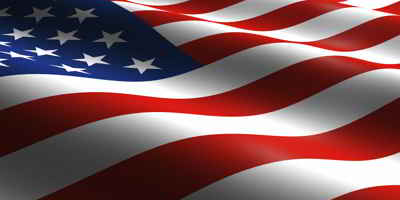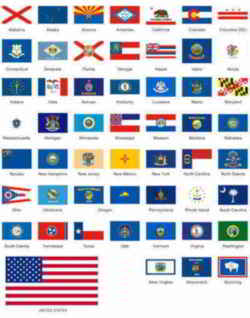

Washington, DC District Flag
Adopted on October 15, 1938
The flag of Washington, DC was adopted on October 15, 1938. The flag of the District of Columbia, consists of three red stars above two red bars on a white background. It is an armorial banner based on the design of the coat of arms of George Washington, first used to identify the family in the twelfth century, when one of George Washington's ancestors took possession of Washington Old Hall, then in County Durham, north-east England. As elements in heraldry, the stars are properly called mullets.
The Washington, DC District Flag
Without either a local or self government, the District of Columbia was very slow to develop a seal or flag of its own. The first seal, designed in 1871 by the Legislative Assembly of the District, included representations of the Capitol building, the American eagle, the figure of Justice, and George Washington. Over the next number of years, several unofficial flags were flown displaying the seal- usually the flag of the D.C. National Guard. In 1920, a commission was established to choose a unique design for the flag of the District of Columbia.
In 1938, Congress established a commission to choose an official, original design.
The commission held a public competition, and picked the submission of graphic designer Charles
A.R. Dunn, who had first proposed his design in 1921.
His design was officially adopted on October 15, 1938, using the following specification:
The proportions of the design are prescribed in terms of the hoist, or vertical height, of the flag as follows: the upper white portion shall be 3/10 of the hoist; the two horizontal bars are each 2/10 of the hoist; the white area between the bars 1/10 of the hoist; and the base, or lowest white space, is 2/10 of the hoist. The three five-pointed stars have a diameter of 2/10 of the hoist and are spaced equidistant in the fly, or horizontal, dimension of the flag.
In 2002, the D.C. Council debated a proposal to change the flag in protest of the District's lack of voting rights in Congress. The new design would have added the letters "D.C." to the center star and the words "Taxation Without Representation" in white to the two red bars, a slogan already in use on the District's license plates. The change presumably would have been temporary and revoked once the city achieved equal representation or statehood. It passed the council on a 10-2 vote, but support for the proposal soon eroded, and then-mayor Anthony A. Williams never signed the bill.

The Flags of the US.





